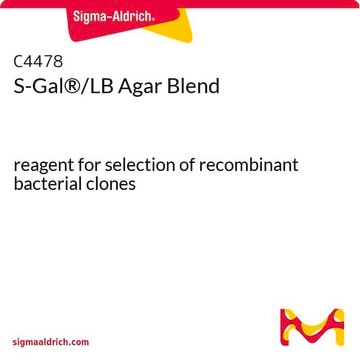S9811
S-Gal®
reagent for selection of recombinant bacterial clones
Synonim(y):
3,4-Cyclohexenoesculetin β-D-galactopyranoside
About This Item
Polecane produkty
klasa czystości
for molecular biology
sterylność
non-sterile
Próba
≥95% (HPLC)
Postać
powder
rozpuszczalność
DMF: 50 mg/mL
przydatność
suitable for β-galactosidase test
temp. przechowywania
room temp
ciąg SMILES
OC[C@H]1O[C@@H](Oc2cc3OC(=O)C4=C(CCCC4)c3cc2O)[C@H](O)[C@@H](O)[C@H]1O
InChI
1S/C19H22O9/c20-7-14-15(22)16(23)17(24)19(28-14)27-13-6-12-10(5-11(13)21)8-3-1-2-4-9(8)18(25)26-12/h5-6,14-17,19-24H,1-4,7H2/t14-,15+,16+,17-,19-/m1/s1
Klucz InChI
HDJJDRXZHJRVGA-DIKXUDHVSA-N
Opis ogólny
Zastosowanie
Cechy i korzyści
- More intense color contrast than X-gal
- Excellent for use in automated colony counters
- Autoclavable for easiest use
- No need to make stock solutions
Inne uwagi
formulation. A medium prepared with S-Gal® is moderately dark due to the presence of ferric ammonium citrate. This darker background often provides enhanced contrast for automated colony counting or isolation.
Zasada
Rekonstytucja
Informacje prawne
produkt powiązany
Hasło ostrzegawcze
Warning
Zwroty wskazujące rodzaj zagrożenia
Zwroty wskazujące środki ostrożności
Klasyfikacja zagrożeń
Eye Irrit. 2 - Skin Irrit. 2 - STOT SE 3
Organy docelowe
Respiratory system
Kod klasy składowania
11 - Combustible Solids
Klasa zagrożenia wodnego (WGK)
WGK 3
Temperatura zapłonu (°F)
Not applicable
Temperatura zapłonu (°C)
Not applicable
Środki ochrony indywidualnej
dust mask type N95 (US), Eyeshields, Gloves
Certyfikaty analizy (CoA)
Poszukaj Certyfikaty analizy (CoA), wpisując numer partii/serii produktów. Numery serii i partii można znaleźć na etykiecie produktu po słowach „seria” lub „partia”.
Masz już ten produkt?
Dokumenty związane z niedawno zakupionymi produktami zostały zamieszczone w Bibliotece dokumentów.
Produkty
Ogólne protokoły wzrostu komórek kompetentnych i ich transformacji (pobieranie DNA).
General protocols for growth of competent cells and their transformation (uptake of DNA).
Protokoły
Technical Article on competent cells. Transformation is a process by which some bacteria take up foreign genetic material (naked DNA) from the environment.
Artykuł techniczny na temat komórek kompetentnych. Transformacja to proces, w którym niektóre bakterie pobierają obcy materiał genetyczny (nagie DNA) ze środowiska.
Nasz zespół naukowców ma doświadczenie we wszystkich obszarach badań, w tym w naukach przyrodniczych, materiałoznawstwie, syntezie chemicznej, chromatografii, analityce i wielu innych dziedzinach.
Skontaktuj się z zespołem ds. pomocy technicznej







